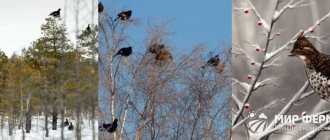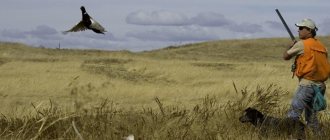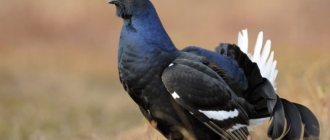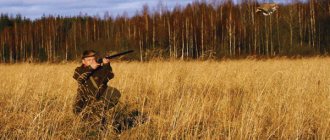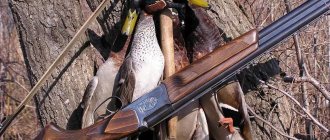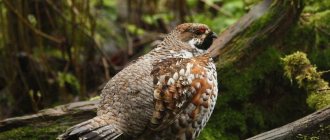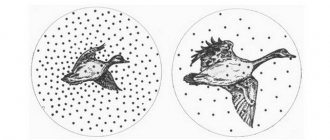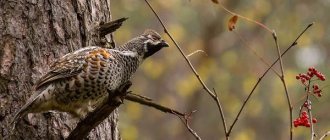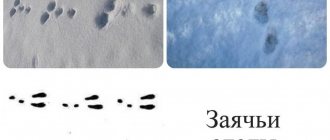Winter hunting for wood grouse is called one of the most exciting active entertainments, because in order to catch such game you need to have accuracy and dexterity, since wood grouse are very careful and timid birds. In the past, this type of hunting was quite popular, but now it is more of a sport than a commercial species.
Despite the fact that catching such a trophy is associated with certain difficulties, armed with theoretical knowledge and the experience of other hunters, you will be able to catch this bird. In today’s article we will look not only at the basic habits of the capercaillie and the features of winter hunting for it, but also consider the most effective ways to obtain a trophy.
- From the approach
Hunting for wood grouse in winter
In general, hunting wood grouse in winter is considered to be in many ways similar to hunting black grouse, although some differences still exist (Figure 1).
Note: Wood grouse are extremely shy birds, and without certain camouflage skills, not all hunters manage to get within shooting distance of the game. But, if you study in detail the habits of the bird and the characteristics of its prey, you may well become the proud owner of such a trophy.
Tracking and attempting to shoot a bird ignites the hunter's excitement, but the hunter must have the patience, endurance and skill to shoot this extremely wary bird. In the past, people went for prey mainly from July to the end of autumn, while in winter they preferred to catch birds with snares. From March to mid-summer, when wood grouse chicks hatch, hunting them is prohibited.
Figure 1. External features of birds
At the moment, the approach method is considered the most honorable subtype of hunting. It is practiced mainly in winter, and the hunter who managed to get a trophy in this way can be truly proud of himself.
Hunting for wood grouse on a lek: main features
Having tracked where the lek is located and planning to approach it, the hunter must take into account the direction of the wind so that an attentive bird does not hear it. As is the case with the credo of movie killers “do not shoot women and children,” when hunting wood grouse in the spring, it is necessary to target only males.
The hunting chances can be calculated by the way the wood grouse displays. If a bird is carried away by loud singing, with elements of play, this indicates its special vulnerability. The hunter may even make an unsuccessful shot, and the potential prey does not always react to the sound as a danger, continuing to remain in place. However, you should not hesitate: you need to reload the gun as quickly as possible and fire an aimed shot.
If the singing was interrupted and wheezing was heard, perhaps the prey sensed danger. The hunter must hide for a while, and only when the overflowing notes arise again should he aim and shoot.
The wood grouse is distinguished by its will to survive. Even when wounded, he does not give up trying to save himself. If there is no appropriate action on the part of the hunter, the shot bird may run away. The most effective target for hitting is the side of the body, and the most favorable time for hunting is dawn.
Description and habits of wood grouse
Capercaillie are wild birds that in nature are found mainly in coniferous and mixed forests. According to zoological classification, they belong to the pheasant family: and indeed, the regal appearance of wood grouse makes them in many ways similar to domestic pheasants.
The best prey is a male capercaillie, because its weight can reach 6 kg. Females are much smaller, and their body weight rarely exceeds 2 kg. In addition, males look much more attractive: their fan-shaped tail is black and covered with beautiful white spots. The plumage on the body is uneven, and its shade can range from black to ashy with slight splashes of brown, white and gray. The chest is green with a steel tint (Figure 2).
In terms of the shade of their plumage, females are very different from males: they are colored predominantly in reddish shades with white, brown, black, yellow and red splashes.
The fact that capercaillie can be caught not only in summer, but also in winter, is explained by the fact that these birds remain for the winter in their native lands, using berries in the summer and conifer buds and needles for feeding in the winter. In late autumn, the best treat for them is withered aspen leaves.
Figure 2. Birds prefer to sit on the tops of trees, going down only to feed
Another interesting habit of the bird is that it spends the daytime on the ground, and at night it prefers to climb onto tree branches. In severe frosts, wood grouse plunge into snowdrifts, in which a kind of hole is formed. If a hunter is lucky enough to find them, he can count on a rich haul. It should be borne in mind that in severe frosts, birds can remain under the snow for several days without feeding, digging tunnels for themselves in the snowdrift.
Lifestyle of wood grouse in winter
In order for the extraction of the trophy to be successful, you need to study the habits of the bird in winter in advance. This will help you quietly track wood grouse and approach them within an accurate shot (Figure 3).
The winter habits of game are distinguished by the following features:
- Birds prefer to settle in coniferous forests, since pine buds and needles serve as the basis of their diet in winter.
- During severe cold weather, males and females form separate flocks based on gender. In other words, if you are going to harvest a hen and a cockerel, you will have to hunt two different groups of birds separately.
- If the snow cover is insignificant, wood grouse spend the night on the treetops. When deep snowdrifts cover the ground and frosts intensify, birds prefer to move closer to the ground and spend the night under the snow, in holes.
Figure 3. In winter, birds feed mainly on pine needles and live in small families.
In particularly severe frosts, wood grouse can stay inside a snowdrift for up to three days. This feature of behavior is not very beneficial to the hunter: when a bird climbs into a snowdrift immediately, a hole is formed on the surface, which over time is covered with snow and finding the bird will be extremely problematic.
Note: The main paradox of the capercaillie's habits is that, contrary to its name, it has surprisingly acute hearing, so you need to be extremely careful when sneaking up on a flock: any rustle or crunch of branches can scare away the game.
When planning a winter hunt for wood grouse, you should take into account one more feature of the birds: they are extremely sensitive to the weather and know in advance about the approach of severe frosts. On the eve of cold weather, wood grouse eat heavily and dive into snowdrifts to wait out the frost. Accordingly, if a hunter goes fishing on days when the air temperature drops below -20 degrees, he is likely to get a trophy.
Winter hunting for wood grouse - interesting video and useful tips
Hunting for wood grouse in winter is an interesting activity that ignites the passion of the hunt. However, at the same time it is not easy, because wood grouse are distinguished by caution and timidity. Many hunters never managed to catch the coveted bird. Now we will tell you about tricks that will help you get the desired trophy and, when you come home, boast of your booty. In some ways, hunting wood grouse is almost no different from hunting black grouse, because these birds are related. But before you begin the extraction methods, you need to figure out what kind of bird it is.
The capercaillie is a fairly large bird that can weigh up to 7 kilograms. The female is an order of magnitude smaller - about 4 kilograms. The male capercaillie has a magnificent variegated coloration. The head and neck are grayish, with black patterns; the black crop has a greenish tint; the breast and neck are black-brown. The dark abdomen is painted with white spots, as is the tail. The back is brown, and the wings are slightly reddish.
But the female is dressed more modestly. It is painted brown with transverse white patterns. This distribution of colors makes it invisible during hatching. The bird got its name because of its ability to “go deaf.” This is due to the fact that there is a special blade in the posterior bend of the external auditory canal. It contains many blood vessels. When a capercaillie becomes very excited during mating, the vessels swell, and one bone presses on them. The capercaillie hears nothing, but sees everything perfectly. This bird lives in coniferous forests. In winter, wood grouse form separate male and female flocks. The hunter will need to make every effort if he wants to get different-sex individuals.
This is interesting: Goose hunting in the Leningrad region
When the snow cover is still small, the birds spend the night on pine trees, where they are difficult for predators to reach. When there is a lot of precipitation and it gets cold, wood grouse move to snow holes.
Severe frosts force one not to leave its hole for more than 3 days, which complicates the search for the bird, because its traces become difficult to find. The capercaillie is very shy, so you need to approach its supposed hole extremely quietly.
The weather plays an important role. You should go hunting during frosts (more than 20° below zero), because at this time a well-fed bird does not leave its shelter for a long time. When the temperature outside is less than 15° below zero, wood grouse actively begin searching for food. If the temperature is close to zero, then wood grouse completely crawl out of their holes and spend the night in the trees. The type of weapon does not matter, but most often hunters choose a smoothbore gun with a shot number of 1-2.
Basic rules of winter hunting
Capercaillie is considered one of the most valuable trophies, since it is extremely difficult to get it, regardless of the season. Birds are distinguished by amazing visual acuity, so it is almost impossible to get close to them unnoticed: usually wood grouse notice a hunter before he comes within shooting distance of them (Figure 4).
Note: Some hunters prefer to take a dog with them as an assistant, as they believe that wood grouse will not regard it as an enemy and will give the hunter the opportunity to get closer. However, in practice, this method does not always work due to the weather: if there is deep snow in the forest, the dog simply will not be able to walk through it.
If we talk about the basic rules of hunting game, then the following tips will be useful for novice hunters:
- First of all, you need to try to detect a flock of birds, quietly approach it and make a well-aimed shot. But this sounds simple only in theory, but in practice, hunting wood grouse is considered one of the most difficult.
- Wood grouse lead a predominantly sedentary lifestyle. In other words, if the flock has found a place suitable for feeding, it will remain there constantly until the food runs out.
- Finding a place for wood grouse to feed and spend the night in a pine forest is not so easy, since any clearing or clearing may be suitable. Therefore, you should be prepared in advance for a long combing of the forest.
- When a flock is discovered, you should not think that the prey is already in your pocket. Wood grouse spend the night on the top of pine trees, from where an excellent view of the area opens up, and they notice the hunter much earlier than he does them, and manage to move away.
- It is better to go hunting for a trophy in windy weather. At this time, the capercaillie cannot accurately determine where the rustling is coming from and the hunter can get close to the flock at a distance of 100-150 meters, which will be quite enough for an accurate shot.
- It should be remembered that haste in hunting wood grouse is the last thing. If you have already managed to get close to the flock undetected, you should not rush. Aim carefully and fire an accurate shot. As practice shows, after the first rifle salvo the flock moves away and there will be no opportunity to try again.
Figure 4. Winter trophy hunting is a very exciting activity.
If you have chosen the right timing and weather conditions for hunting, you should take into account several more features of wood grouse. Firstly, these are quite heavy birds, so they cannot take off quickly. This will give the hunter a few seconds to take aim.
Secondly, wood grouse are quite tough to wound, and even if you fire a deadly shot, the bird can fly quite far. Based on this feature, increased attention should be paid to the preparation of weapons and equipment.
Hunting for Toku
Wood grouse begin to breed much earlier than other birds. Hunting for leks begins in mid-February. At this time, the birds are so passionate about procreation that they devote themselves completely to this matter. The hunter can easily find the places where the mating dances of males took place by scattered feathers. Since wood grouse are sedentary birds, males come to the mating site every year. You can find wood grouse by their singing, which is performed to attract females. The bird can sing not only in the trees, but also on the ground. While the wood grouse is singing on the ground, the hunter can successfully make several shots. The attention of males is focused exclusively on females, which the hunter can take advantage of.
When a flock is discovered, there is no need to rush to approach it. It is better to wait some time so that all males are involved in the mating process. The hunter must behave as quietly as possible. When the right time has come, you need to aim well. Birds, keen on procreation, cannot immediately predict the course of all events, but the hunter has an additional attempt. An important factor on which everything depends is the weather. Wood grouse are excellent weather forecasters, so to plan your hunting day you need to monitor the weather forecast. If it is cold, the breeding season for birds will be postponed.
Preparing equipment
To get a trophy, you should prepare a suitable weapon in advance. You can go hunting for wood grouse with both a rifled and smooth-bore gun, but recently combined multi-barreled models have also become popular.
When choosing a weapon type, objectively weigh your shooting skills and the features of the gun. For example, a rifle allows you to capture prey from a long distance, but the owner must have a keen eye. If you cannot boast of special shooting skills, you will have to abandon rifled weapons.
Note: It should also be taken into account that the use of rifled weapons has certain restrictions. Due to the range of the bullet, it cannot be used near highways or villages.
When it comes to smooth-bore weapons, it is better to give preference to double-barreled shotguns - if the first shot is unsuccessful, you can always try again without wasting time on reloading.
Figure 5. Required equipment
In addition to selecting weapons, you will have to take care of your own comfort, that is, warm clothes that do not restrict movement. Be prepared for the fact that you will have to wander through the forest for a long time or sit in ambush, so both clothes and shoes should be warm and spacious. It is better to choose a hat that is light but warm so that it does not get confused during a long walk. It is also advisable that the color of the equipment be camouflage: this way you will have more opportunities to get closer to the flock. And, naturally, it is better not to wear clothes that make noise and rustle (Figure 5).
Weapon
When choosing weapons and equipment for hunting wood grouse, play a key role in choosing the right gun. In principle, any firearm is suitable for this purpose, but the double-barreled shotgun is considered the most practical. Firstly, it allows you to fire two shots in a row, increasing your chances of getting a trophy. Secondly, it does not contain garbage, which is present in abundance in any forest.
Note: Hunters also leave positive reviews for domestic shotguns IZH 12, 26, 27, 54 and 58 and TOZ 25, 63, BM.
When deciding on the type of gun, be sure to take into account its weight: it is better to give preference to a light model, since it is possible that in search of a flock you will have to make long treks.
The following advice from experienced fishermen will help you avoid mistakes during shooting:
- Correctly assess the distance to the target: as a rule, it is this nuance that causes an insufficiently accurate shot. Remember that you will only have one chance to get a trophy, so either train your eye in advance, or place markers on the ground that will help you accurately determine the distance to the flock.
- Learn to shoot after a flying bird: if the capercaillie is high in the sky, you can take aim at it, but if the bird is flying low, it is better to cover it with trunks to prevent it from settling. Shooting like this requires practice. In addition, if the prey rises steeply, it is better to shoot not directly at it, but in advance, slightly above the target.
- Remain calm: this requirement is difficult to comply with, given how exciting grouse hunting is considered to be. But try not to get too nervous, so as not to pull the trigger ahead of time.
Also keep in mind that you only need to take a shotgun with you when fishing: an unfamiliar weapon in most cases leads to annoying mistakes.
Ammo
In addition to the correct choice of gun, the selection of suitable cartridges is also considered equally important. Experienced hunters recommend using Mirage, SKM-Industry or Fetter ammunition. As a rule, it is these cartridges that play a decisive role in the success of the hunt.
Types of wood grouse hunting
There are several ways to obtain a capercaillie carcass, depending on the time of year and the habits of the birds in a certain period. Experienced hunters advise familiarizing yourself with each type of hunting in advance so that you can quickly navigate the area.
Next, we will look at the main types of game production with their characteristics and theoretical information that will help you become the proud owner of a bird.
From the approach
Hunting for wood grouse from the approach is practiced mainly in autumn or early winter, when the birds are still feeding in deciduous forests. However, in some cases this method is also applicable for snowy winters (Figure 6).
Figure 6. Getting a trophy from the approach
The main feature of approach hunting is to find a feeding area for birds. You can determine it with binoculars, carefully examining the area from an elevated position. But many experienced hunters prefer to rely on hearing: since the capercaillie is a fairly large bird, it makes a lot of noise when flying up a tree or tearing leaves from the trunk. For example, if a capercaillie flies to the top, the noise of its wings spreads through a quiet forest for 400 meters, and during feeding, the noise of leaves being torn off will be heard from a distance of 200 meters.
If you have already managed to locate the birds' feeding area, you will need:
- Build a small hut with a wide view. It is highly advisable to disguise it so that the birds do not realize your presence.
- Try not to focus on one flock: it is possible that there are other birds nearby. To make sure of this, it is better to carefully walk around the area.
- Always have a gun with you: if you accidentally approach the flock within shooting distance, you will have to hit the target immediately. Due to their timidity, birds are unlikely to return to the old feeder any time soon if they are frightened away by a person.
- If you notice several wood grouse sitting on branches, it is better to aim at those located lower.
It is best to hunt from the approach in wet weather, since at this time you will be able to move unnoticed through the forest. In addition, on cloudy days, wood grouse can sit at the feeder almost all day, while in sunny weather they go down to them only in the morning and evening.
On current
For wood grouse, the start of the breeding season begins much earlier than for other wild birds, so at the end of winter it is quite possible to practice lek hunting. The best time for catching a trophy using this method is considered to be the end of February, and with the arrival of the first spring warmth, the birds will begin to go to the mating site (Figure 7).
Such a place can be detected by some characteristic signs:
- In an open clearing, many bird tracks will be visible, and the wing tracks of males performing a mating dance will be more clearly visible.
- There is no specific place for mating, since wood grouse can choose completely unexpected locations for this purpose, regardless of the area and landscape.
- Wood grouse have one peculiarity - they come to mating in the same place year after year. In other words, if you have already discovered such a clearing, you may well be able to return to it next year.
- The bird can also be detected by a very characteristic sound - singing, with which males attract females.
- If the place for mating is hidden deep in the forest and the birds feel safe, they can be not only on the treetops, but also on the ground.
Figure 7. Shooting game on a lek
The advantage of hunting wood grouse on a lek is that the attention of the males is completely diverted to the hens, so they may not notice the approach of the hunter. At the same time, you don’t need to try to shoot the bird right away: it’s better to find shelter and wait about half an hour for all the cockerels to start singing. As soon as the entire flock is involved in the mating process, you need to carefully aim and shoot. As a rule, the birds are so carried away that they may not even notice the gunshot, and the hunter will have the opportunity to fire a second shot.
On the holes
In snowy and frosty winters, wood grouse hunting in holes is often practiced. Despite the fact that this type of trophy production is considered one of the most profitable, it is associated with certain difficulties. First of all, you will have to find the place where the capercaillie lay down for the night (Figure 8).
Note: The hole is a depression in a snowdrift into which the capercaillie climbs to hide from the frost. As a rule, the holes are located directly near the feeding site, but this is not always the case.
The obvious advantage of such hunting is that wood grouse prefer to lead a sedentary lifestyle. If you have already located a cluster of holes, you can always return to this place to shoot birds.
To ensure a successful hole hunt, follow these rules:
- You need to sneak up to the location very carefully, since the birds’ hearing acuity is not reduced even by a thick layer of snow.
- When holes are found, try to determine their freshness. This will help determine if they contain game. First, there should be marks near the hole. Secondly, there should only be one hole. If there are several of them, this means that the game has changed its sleeping place, getting out through the second hole.
- Next, you need to lure the bird out of the hole. To do this, you can make a special noise so that the game starts to come out of the hole. The hunter will only have to aim accurately and make an accurate shot.
Figure 8. This is what the holes look like.
Some hunters prefer to catch game with their bare hands, without firing a single shot. There is a definite advantage in this method, because as a result you will receive a completely intact carcass, especially since capercaillie get out of their hiding place very slowly. However, it should be borne in mind that this bird is large and strong, so handling it can be problematic.
With dogs
Many hunters prefer winter hunting with a dog for many reasons. Firstly, wood grouse are extremely strong birds, and even after being mortally wounded they can fly a certain distance. In this case, the dog will help find prey in the forest (Figure 9).
Figure 9. A dog is the best assistant in hunting game
Secondly, the animal’s keen sense of smell can help find the habitat of wood grouse and quietly approach them within shooting distance. The only drawback of this type of hunting is that in a snowy winter the dog will not be able to move freely through deep snow and it will be possible to walk with it through the forest only on roads.
Hunting for wood grouse from the approach in winter. Peculiarities.
The hunter needs to find a group of wood grouse, get close to them as unnoticed as possible and shoot accurately. It all sounds quite simple, but in reality it is not so easy. But there are also certain tricks. If a capercaillie has found an excellent place for feeding, then it will visit it for a certain time. Finding this small corner of the forest is not easy, so you will need to walk for a long time.
If the pack is found, then half the job is done. But, oddly enough, from this moment the problems begin. The capercaillie is at the top of the trees and clearly sees the approaching danger. The bird sees the hunter before the hunter sees it. Therefore, the bird calmly flies to a safe place. The dense crowns of trees, which camouflage it, also benefit the capercaillie. But the wind benefits the hunter. When the winds blow, the capercaillie cannot navigate where the sounds are coming from.
To shoot, you should stand at a distance of about 150 meters from a group of wood grouse. There is no need to rush anywhere, because there is only one chance of a shot. A flock of birds will immediately rush to fly away if they hear the sound of a gunshot. Having aimed well, you can shoot. The main thing is to hit the capercaillie accurately, because a bird with a severe wound can fly up to 200 meters, and with a slight wound it can fly far, far away. This is important to remember. You also need to remember that due to its decent weight, it is difficult for the capercaillie to quickly rise into the sky.
In order not to miss a wounded capercaillie, you can take a dog with you as a partner. The dog is able to sniff out a flying capercaillie, and also hear it at a great distance. Another plus is that the capercaillie, when he sees the dog, is 100% confident in his safety and focuses all his attention on it. During this time, the hunter can get close enough to shoot. If you suddenly see several wood grouse on one tree, then first you need to shoot at the lower birds so as not to scare everyone away. Wood grouse can be found near roads and quarries, since in order to successfully digest winter food they need pebbles, which they swallow. Without noticing the hunter doing this, they can become his prey. Watch a detailed video of hunting wood grouse in the winter season.
Useful tips
Since winter hunting for wood grouse is considered quite difficult, you need not only to prepare for it, but also to listen to the advice of experienced hunters.
Getting a trophy will be successful if you:
- You will move through the forest on skis: this way you will not only reduce fatigue from long treks, but will also make less noise.
- Prepare your weapon in advance: Since shooting a capercaillie often requires the first attempt, you should be familiar with the gun.
- Correct selection of ammunition: it is difficult to shoot a capercaillie in one shot, especially from a great distance, due to the strength and toughness of the bird. Therefore, it is better to take large-caliber cartridges.
When in the forest, use caution and constantly check your surroundings. Be aware of the keen vision and hearing of capercaillie and try not to make a lot of noise. Only in this case will you be able to get close to the flock at a distance sufficient to shoot.
The video shows one of the most interesting types of wood grouse hunting - on holes.
